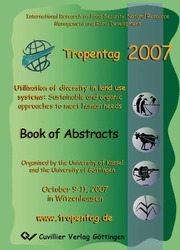| Departments | |
|---|---|
| Book Series (96) |
1378
|
| Nachhaltigkeit |
3
|
| Gesundheitswesen |
1
|
| Humanities |
2364
|
| Natural Sciences |
5406
|
| Mathematics | 229 |
| Informatics | 319 |
| Physics | 980 |
| Chemistry | 1363 |
| Geosciences | 131 |
| Human medicine | 243 |
| Stomatology | 10 |
| Veterinary medicine | 108 |
| Pharmacy | 147 |
| Biology | 835 |
| Biochemistry, molecular biology, gene technology | 121 |
| Biophysics | 25 |
| Domestic and nutritional science | 45 |
| Agricultural science | 1004 |
| Forest science | 201 |
| Horticultural science | 20 |
| Environmental research, ecology and landscape conservation | 148 |
| Engineering |
1793
|
| Common |
98
|
|
Leitlinien Unfallchirurgie
5. Auflage bestellen |
|
Advanced Search
Tropentag 2007 (English shop)
Utilisation of diversity inland use systems: Sustainable and organic approaches to meet human needs
Eric Tielkes (Editor)Preview
Table of Contents, Datei (7.9 KB)
Extract, Datei (48 KB)
The TROPENTAG is an International Conference for Research on Food Security, Natural Resource Management and Rural Development. Since 1999 it is convened alternately by a number of German Universities in co-operation with ATSAF and GTZ/BEAF, all of which are engaged in agriculture and forestry in tropical countries.
The TROPENTAG provides an international platform for scientific and personal exchange for students, junior and senior scientists, and development practitioners alike. The increasing international interest in the TROPENTAG from a large and still growing audience – over 650 participants from 68 countries have registered for the 2007 conference – demonstrates its importance on the agenda of both, the development oriented scientific community and the implementing development organizations.
This year’s TROPENTAG is organised jointly by the University of Kassel-Witzenhausen and the University of Göttingen under the conference theme “Utilisation of diversity in land use systems: Sustainable and organic approaches to meet human needs”. This theme covers many challenging aspects: diversity may refer to the (genetic) diversity of the natural resource base on which anthropogenic land use relies, and to the entire ecosystem with which this land use is interacting. Here, we understand diversity in a broad sense: it encompasses the diversity of the natural flora and fauna at the micro to the macro scale, and also, for example, variation of soils or site conditions. Diversity may also refer to the genetic diversity of domesticated plant and animal species, which over millennia supports livelihoods in almost all climates and regions worldwide. Utilizing diversity may mean harvesting non-timber forest products such as mushrooms, medicinal plants or wildlife, or to combine different crops in intercropping systems to better exploit compatibilities in time or space securing multiple household needs. Diversity may also refer to the large cultural diversity of human societies in different regions of the world, who have developed their individual knowledge and technologies to derive their livelihoods from the resource base at hand.
New methods and research results are presented addressing the eternal question of how we may reconcile increasing demands for food and energy by a growing world population and peoples’ search for improved livelihoods with our vision of sustainability and conservation of biodiversity in agro-ecosystems. In this context emphasis is also placed on searching for discipline-specific indicators of sustainability and trying to combine these in a way that allows their useful application in assessing land use systems.
| ISBN-13 (Printausgabe) | 3867273723 |
| ISBN-13 (Hard Copy) | 9783867273725 |
| ISBN-13 (eBook) | 9783736923720 |
| Final Book Format | A5 |
| Language | English |
| Page Number | 556 |
| Lamination of Cover | matt |
| Edition | 1 Aufl. |
| Volume | 0 |
| Publication Place | Göttingen |
| Publication Date | 2007-10-08 |
| General Categorization | Non-Fiction |
| Departments |
Agricultural science
Forest science |
| Keywords | Tropical agriculture, ecosystem services, food security, food safety, food quality, natural resources, resource management, research for development, rural development, development organisations, diversity of land use, agroecology, forestry, agroforestry, aquaculture, biodiversity, homegardens, livestock. |








